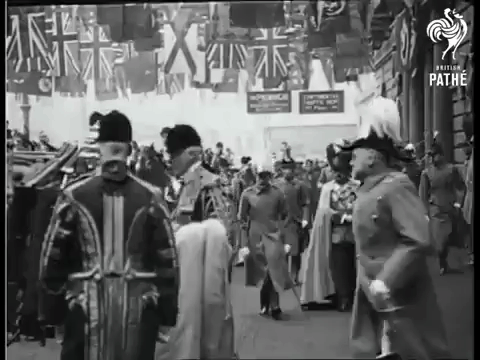 |
| King George V and King Amanullah at the start of the 1928 state visit |
The whole range of state rooms at Buckingham Palace were last night converted into floral arbours for the state banquet in honor of the King and Queen of Afghanistan [1]. There were flowers everywhere. In the banqueting hall itself rhododendrons, azaleas, and similar plants were massed against the walls; spring flowers were mingled with them, and daffodils, ranging from palest yellow to deepest gold, formed the table decoration. No setting could have been more fitting for the brilliant scene that was staged. The uniforms of the Afghans, the glittering orders of the men, the blaze of jewels worn by the women, the gorgeous medieval uniforms of the Yeomen of the Guard, could have asked no better background.
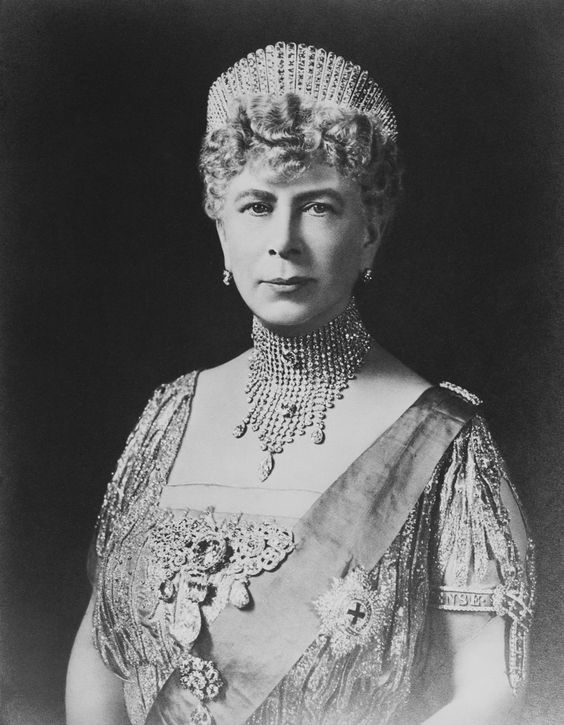 |
| A glittering portrait of Queen Mary wearing diamonds, ca. 1930s; she is wearing the Koh-i-Noor Diamond affixed to the Cockade Ornament, as well as the “Lesser Stars of Africa,” the Cullinan III and IV Brooches (Wikimedia Commons) |
The guests assembled in the Green Drawing-room, and the King and Queen [2] awaited them in an inner drawing-room. The King wore the uniform of an Admiral of the Fleet. Queen Mary’s magnificent gown was of silver tissue, with an over-dress of paillettes shading from opal to soft Persian blue. Row upon row of diamonds decorated the corsage. She wore a diamond tiara, the Lesser Stars of Africa as a pendant [3], and the famous Koh-i-Noor diamond [4]. Her principal order was the “Almar-i-Ala,” [5] the highest order in the gift of the King of Afghanistan, which King Amanullah conferred upon his arrival yesterday. She wore the ribbon, the star, and the collar of the order, and also the M.V.O. among other family orders.
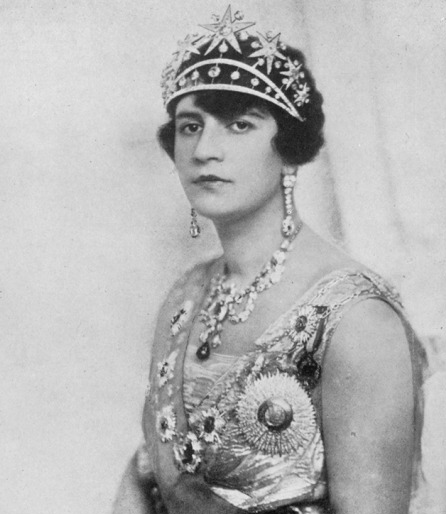 |
| A bejeweled portrait of Queen Soraya of Afghanistan, possibly taken in Germany during the royal couple’s 1928 tour of Europe (Wikimedia Commons) |
The Queen of Afghanistan wore a dress of silver tissue oversewn with gleaming sequins, the effect in the brilliant lights of the Banqueting Hall being a moonlight on water. In her brown hair she wore a magnificent diamond tiara and she had ropes of diamonds about her corsage. Her arms were encircled with diamond and sapphire bracelets and numerous orders gleamed upon her breast.
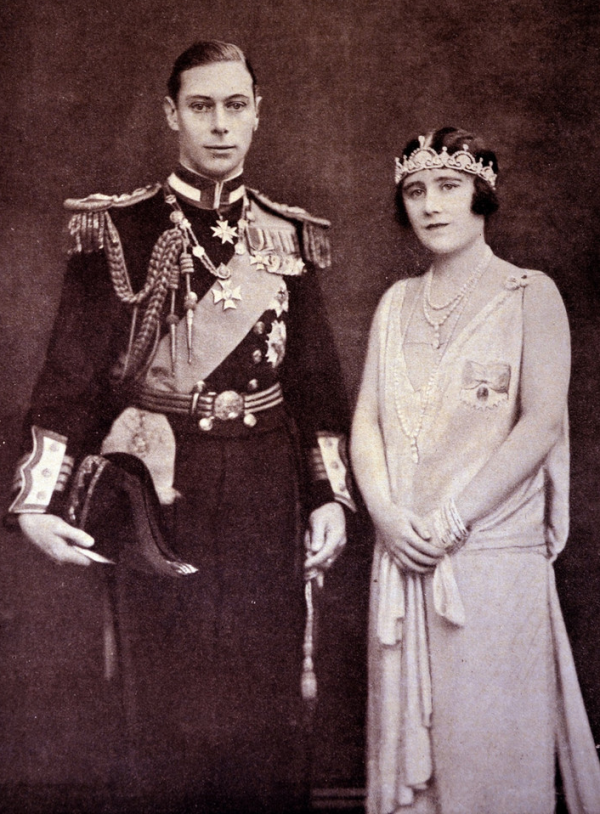 |
| A 1920s-era portrait of the Duke and Duchess of York, later King George VI and Queen Elizabeth; she appears to be wearing the jewels (and perhaps even the gown) described in this article |
The Duchess of York [6] was a dainty figure in a cream satin gown with a long train, both dress and train being embroidered with silver. Her jewels were a diamond and pearl tiara [7], three strings of pearls, and ruby, emerald, sapphire, and diamond bracelets [8]. She wore an Afghan order in addition to family orders.
The King of Afghanistan wore a wonderful scarlet, light blue, and silver uniform, with many orders upon his breast. The Prince of Wales [9] was in Welsh Guards uniform, the Duke of York [10] in the blue of the Air Force, and Prince Henry [11] in Hussars dress.
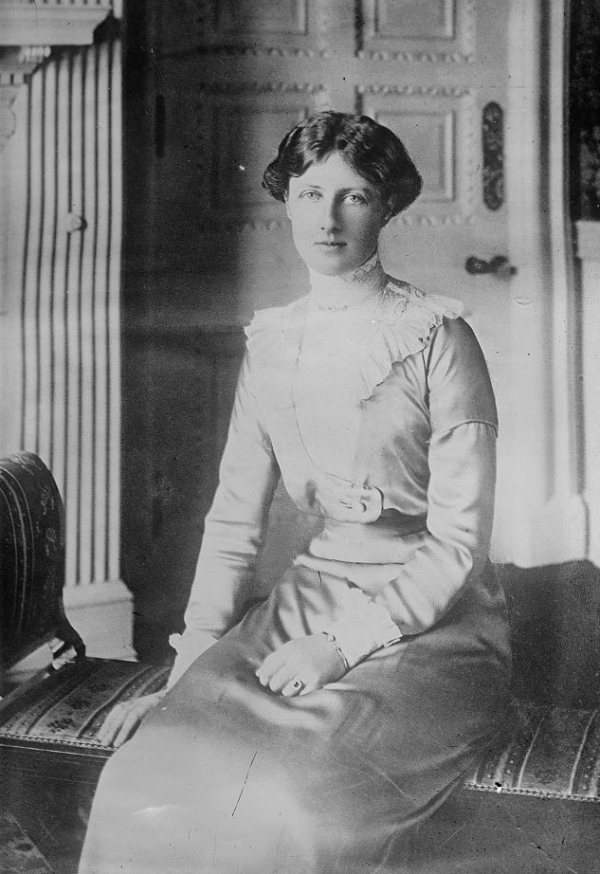 |
| A portrait of Princess Alexandra, Duchess of Fife, who was better known as Princess Arthur of Connaught during her lifetime (Library of Congress/Bain News Service/Wikimedia Commons) |
The King, with the Queen of Afghanistan, led the way to the Banqueting Hall, followed by the King of Afghanistan, with Queen Mary, and the other guests. The King sat at the head of the table, the King of Afghanistan on his right and the Queen of Afghanistan on his left. The Queen sat on the right of King Amanullah. The left-hand neighbour of the Queen of Afghanistan was the Prince of Wales, with Princess Huriya Tarzi [12] on his left. The Duke of York was next to Princess Huriya Tarzi, with Princess Arthur of Connaught [13] as his other neighbor. The order of the guests on the right of the Queen was H.E. Muhammad Hassan Khan [14], the Duchess of York, Prince Henry, Marques Merry del Val (the Spanish ambassador) [15], and Prince Arthur of Connaught [16].
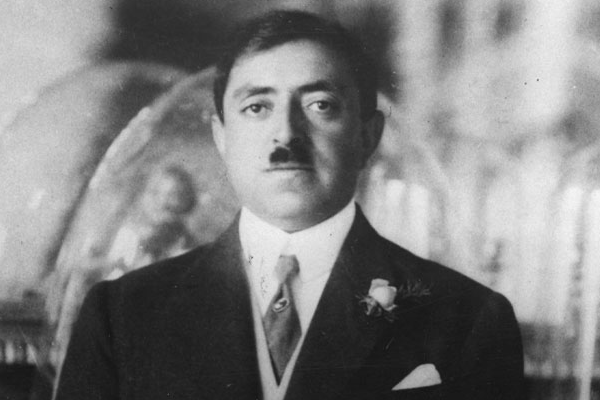 |
| King Amanullah of Afghanistan in morning dress, ca. 1930 (Wikimedia Commons) |
The famous gold plate was arranged upon the table and on the sideboards in the Banqueting Hall. During the banquet the string band of the Royal Artillery played in the musicians’ gallery at the end of the long chamber.
Among the guests were the Archbishop of Canterbury and Mrs. Randall Davidson [17], the Prime Minister and Mrs. Baldwin [18], other Cabinet Ministers, Lord and Lady Reading [19], Lord and Lady Allenby [20], Mr. Lloyd George [21], and Mr. Ramsay MacDonald [22].
At the end of the banquet the King made a speech welcoming his guest, and the King of Afghanistan replied.
NOTES
1. King Amanullah of Afghanistan (1892-1960) reigned over the country from 1919 until 1929, first as sovereign prince and then as king. Both King Amanullah and his wife, Queen Soraya (1899-1968), were progressive and forward-thinking, embarking on modernizing projects that ultimately led to conservative backlash. During the couple’s 1928 trip to Europe, which included this state visit, an uprising at home led to his abdication the following year. The couple went into exile in Europe, living in Italy and Switzerland.
2. King George V (1865-1936) and Queen Mary (1867-1953) of the United Kingdom sat on the British throne in March 1928. The king’s health had been questionable since the mid-1920s, and in late 1928, he suffered an attack of septicemia serious enough that the Prince of Wales took over many of his royal duties.
3. The “Lesser Stars of Africa” are the Cullinan III and IV Diamonds, two of the stones cut from the massive Cullinan Diamond in 1908. They are often worn together as a brooch or pendant. (The Cullinan I is known as the “Great Star of Africa,” while the Cullinan II is often called the “Second Star of Africa. Those diamonds are set in the Sovereign’s Sceptre with Cross and the Imperial State Crown, respectively.) You can read more about the Cullinan III and IV Brooch over here.
4. Am I the only one who gasped at the thought of a British queen wearing the Koh-i-Noor Diamond in front of a King of Afghanistan? Today, that would be tantamount to a political provocation. (More on the Koh-i-Noor, which once belonged to the Kings of Afghanistan, over here.)
5. The Order of the Supreme Sun was instituted in 1920 by King Amanullah and discontinued in 1973. Appropriately, the order’s star was shaped like a stylized sun, as were the decorations on its collar.
6. The Duchess of York (1900-2002), later Queen Elizabeth and then the Queen Mother, was the daughter-in-law of King George V and Queen Mary. In 1928, she was already a popular member of the royal family, known as the “Smiling Duchess.” She had given birth to her first child, Princess Elizabeth (now Queen Elizabeth II) two years earlier, and in 1927, she had embarked on a successful (and grueling) royal tour of Australia with her husband.
7. This is almost certainly the Lotus Flower Tiara, one of her redesigned wedding gifts. The tiara was most recently worn by the Duchess of Cambridge. You can read more about the piece over here.
8. These are the multi-colored, gem-set bracelets from Cartier, purchased for Elizabeth as a gift from her husband. They could be worn together as a tiara, set on a bandeau frame. They’re now owned (and worn) by her daughter, Queen Elizabeth II, and the tiara is one of my long-shot bridal diadem picks for Meghan Markle. You can read more about these bracelets over here.
9. The Prince of Wales (1894-1972), later King Edward VIII and then the Duke of Windsor, was the eldest son and heir of King George V. He was an exceptionally popular member of the family, and in 1928, he was busy with public engagements and love affairs. Two years later, he would meet Wallis Simpson, and his entire life’s trajectory would change.
10. The Duke of York (1895-1952), later King George VI, was the second son of King George and Queen Mary. He was a happily-married father of one daughter (the future Queen Elizabeth II) in 1928; for three years, he had been treated by Lionel Logue to help with his speech difficulties, and he had recently impressed listeners with his improved delivery during the official opening of the new Parliament House in Canberra.
11. Prince Henry of the United Kingdom (1900-1974), later the Duke of Gloucester, was King George and Queen Mary’s third son. A military man, he had been promoted to captain in the 10th Royal Hussars the previous May. Only a few weeks after this banquet, he got another promotion: his father created him Duke of Gloucester, Earl of Ulster, and Baron Culloden. A few months later, though, Henry’s romantic life became a headache for his parents: he met the famous (and married) aviator Beryl Markham while on safari in Africa with his eldest brother. Henry and Beryl conducted a rather public affair for months, until King George decided to distract Henry with a series of foreign assignments.
12. Huriya Tarzi was Queen Soraya’s sister. She later married King Amanullah’s foreign minister, Ghulam Siddiq Charkhi (1894-1962), and settled in Berlin.
13. Princess Arthur of Connaught (1891-1959), previously Princess Alexandra, Duchess of Fife, was a niece of King George and Queen Mary. She married Prince Arthur of Connaught (her first cousin once removed) in 1913. Although she was a royal duchess in her own right, she used her husband’s title after their wedding. Alexandra was a skilled nurse who worked in various medical facilities during and after both world wars.
14. Muhammad Hassan Khan was an Afghan prince who served in various roles in King Amanullah’s court. In 1928, he was Court Chamberlain.
15. Alfonso Merry del Val y Zulueta, Marques de Merry del Val (1864-1943) was the Spanish ambassador to Britain from 1913 until 1931. The son of a career diplomat, he was born in London and had significant Irish ancestry (hence the “Merry” part of his name/title). He was also one of King Alfonso XIII of Spain’s English teachers.
16. Prince Arthur of Connaught (1883-1938) was a grandson of Queen Victoria. His parents were Prince Arthur, Duke of Connaught and Princess Louise Margaret of Prussia; his sisters were Crown Princess Margareta of Sweden and Lady Patricia Ramsay. In 1913, he married another of Victoria’s descendants, Princess Alexandra, Duchess of Fife.
17. Randall Davidson (1848-1930) was Archbishop of Canterbury from 1903 until November 1928. His wife, Edith (d. 1938), was the daughter of another Archbishop of Canterbury, Archibald Campbell Tait. Davidson was the first Archbishop of Canterbury to retire; all his predecessors had died in office.
18. Stanley Baldwin (1867-1947) was in the midst of the second of his three tenures as prime minister in 1928. His wife, Lucy (1869-1945), was a philanthropist who advocated for advances in maternal care.
19. Rufus Isaacs, 1st Marquess of Reading (1860-1935) served in numerous government positions. In 1928, he had recently completed a term as Viceroy of India; he also served as ambassador to the United States, Attorney General, Lord Chief Justice, and Secretary of State for Foreign Affairs. His wife, Alice (1866-1930), was active in charitable work, supporting causes related to women and children during her time as vicereine.
20. Edmund Allenby, 1st Viscount Allenby (1861-1936) was a decorated soldier who became a Field Marshal after his service in the Middle East during World War I. He commanded T.E. Lawrence, and his character features prominently in Lawrence of Arabia. He and his wife, Adelaide, became Viscount and Viscountess Allenby in October 1919.
21. David Lloyd George (1863-1945) served as Britain’s prime minister from 1919 until 1922; in 1928, he was the leader of the Liberal Party.
22. James Ramsay Macdonald (1866-1937) served as Britain’s prime minister twice; in 1928, he was Leader of the Opposition as the leader of the Labour Party.
Leave a Reply